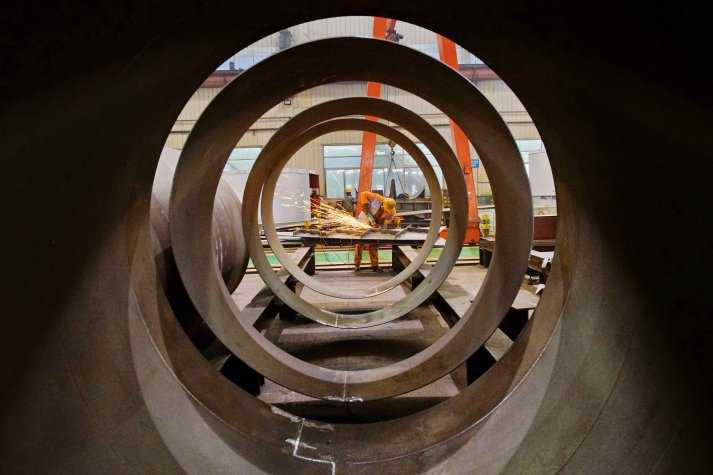| Business |
| Economy Firms up With a Drastic Rebound In Industrial Profit | |
| China's economy has shown signs of robust health with growth of its major industrial firms | |
|
|
 A staff works at the workshop of an equipment manufacturing enterprise in Tangshan, Hebei Province, on December 9, 2018 (XINHUA)
The Chinese economy has shown more signs of robust health, with its major industrial firms posting a 13.9-percent growth in profits in March, compared to the previous year. The figure marked a drastic rebound from the 14-percent decline in the January-February period, according to data released on April 27 by the National Bureau of Statistics (NBS). Thanks to the improving performance in March, these firms posted a 3.3-percent decline in aggregate profit for the first quarter, 10.7 percentage points less than that in the January-February period. In March, the total profit of these firms stood at 589.52 billion yuan ($88 billion). For the first three months, the figure was 1.29 trillion yuan ($191.7 billion). The rebound in industrial profit growth was mainly driven by expanding production and sales. In March, the aggregated industrial value added by these firms surged by 8.5 percent year on year, 3.2 percentage points higher than that in the January-February period. Operation revenues jumped by 13.7 percent year on year this March, 10.4 percentage points more than the January-February period. Senior statistician Zhu Hong from the NBS's industrial department identified stabilizing prices as another driver of the rebound. Producer prices rose 0.4 percent year on year in March, ending a decline for eight consecutive months. Purchasing prices for raw materials edged up 0.2 percent from a year ago, 0.1 percentage points higher than that in the January-February period. Preliminary estimates showed that the price changes added 26.8 billion yuan ($3.9 billion) to industrial profits in March and that the contribution of price changes to industrial profit growth rose by 4.5 percentage points from that in the January-February period, Zhu said. Smaller tax burdens owing to value-added tax cuts, the effect of the Spring Festival, a lower base and higher gains on investment also elevated the profit growth in March, the NBS analysis noted. Key sectors such as the automobile, oil processing, iron and steel, and chemical industries improved their profit making abilities. The auto industry's profit rose by 1 percent year on year in March, reversing a 42-percent decline in the first two months as production and sales both picked up due to price cuts and the launch of new models. Oil processing profits dropped by 13.9 percent from a year earlier, but the decline was 56.5 percentage points smaller than that in the January-February period. The iron and steel and petrochemical sectors saw their profit decline narrow by 43.8 percentage points and 24 percentage points respectively from the January-February period to 15.2 percent and 3.2 percent in March. The data also revealed improving performance of major industrial enterprises. For every 100 yuan ($14.8) of revenue they generated, the costs they bore fell by 0.07 yuan ($0.01) from a year earlier to 92.9 yuan ($13.8) in March, compared to an increase of 0.81 yuan ($0.12) in the January-February period. The liability to assets ratio, an indicator of solvency, dropped by 0.2 percentage points from a year earlier to 57 percent in March. The figure for state-controlled entities fell by 0.8 percentage points year on year to 58.7 percent in March. In addition, it took these firms 17.3 days to sell off their inventories in March, almost one day shorter than a year earlier. The profit margin of these firms stood at 6.13 percent in March, 0.01 percentage point higher than a year earlier, reversing a drastic decline in the January-February period. Previous data from the NBS showed that the Chinese economy got off to a good start in 2019, growing 6.4 percent year on year in the first quarter. Employment, prices and incomes, investment and consumption, and imports and exports all pointed to upward momentum. NBS spokesperson Mao Shengyong said that industrial firms had reasons to further expand as many favorable factors were exhibited. A package of tax cuts and fee reductions would further ease corporate burdens, encourage companies to expand investment and drive production, he said. With liquidity reasonably sufficient, the real economy could get more forceful support from the financial industry, while expanding exports would also shore up steady industrial growth, he noted. This is an edited excerpt of an article by Xinhua News Agency Copyedited by Craig Crowther Comments to liuyunyun@bjreview.com |
|
||||||||||||||||||||||||||||
|